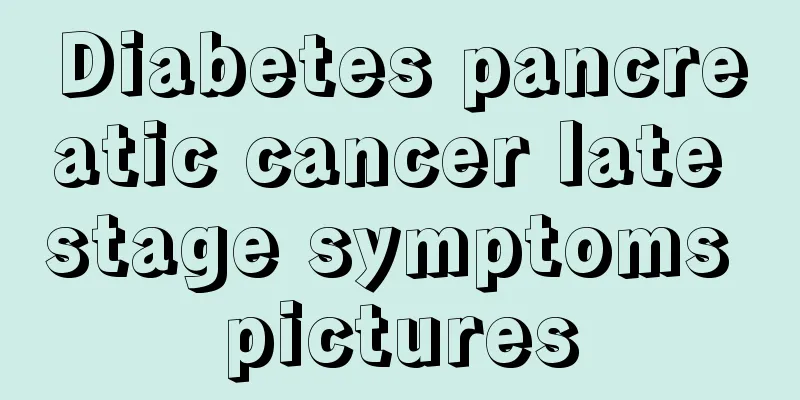Diabetes pancreatic cancer late stage symptoms pictures

|
What are the symptoms of diabetic pancreatic cancer? Diabetics have a high risk of developing pancreatic cancer, and pancreatic cancer is relatively hidden and difficult to detect through early symptoms. Because its onset is similar to the typical symptoms of diabetes, it does not arouse the patient's vigilance, resulting in delayed disease. So, what are the symptoms of diabetic pancreatic cancer? Here are some common pancreatic cancer symptoms to help you detect and treat it early. 1. Symptoms of diabetes: Some pancreatic cancer patients will have symptoms of diabetes in the early stage of the disease, that is, they will first develop diabetes before the main symptoms of pancreatic cancer such as abdominal pain and jaundice appear, so that the accompanying weight loss and weight loss are mistakenly regarded as manifestations of diabetes, and pancreatic cancer is not considered; it can also be manifested as a recent worsening of the condition of patients with long-term diabetes, or the treatment measures that were able to control the condition for a long time become ineffective, indicating that pancreatic cancer may have occurred on the basis of the original diabetes. Therefore, if a diabetic patient has persistent abdominal pain, or an elderly person suddenly develops diabetes, or an original diabetic suddenly worsens recently, they should be alert to the possibility of pancreatic cancer. 2. In addition to the typical symptoms of diabetes, diabetic pancreatic cancer also exhibits the following symptoms: 1. Abdominal pain Abdominal pain is the main symptom of pancreatic cancer, and it occurs regardless of whether the tumor is located in the head or tail of the pancreas. Sixty to eighty percent of patients experience upper abdominal pain, and 85 percent of these patients with pain are no longer able to undergo surgery or are already in the advanced stage. The pain is generally unrelated to diet, and is mostly mild at first, with persistent pain that gradually worsens. Due to the different locations of the tumors and the mechanisms that cause pain, abdominal pain can present in a variety of ways. The severity ranges from fullness and discomfort, dull pain to severe pain and radiating pain. Pancreatic head cancer mostly radiates to the right side, while body and tail cancer mostly radiate to the left side. Pain in the lower back indicates a more advanced stage and a poor prognosis. Pancreatic cancer can cause the pancreas to enlarge and compress the pancreatic duct, causing it to become obstructed, dilated, twisted, and with increased pressure, causing persistent or intermittent pain in the upper abdomen. Sometimes pancreatitis is also present, causing visceral neuralgia. The abdominal pain of typical pancreatic cancer often worsens when lying on your back, especially at night, forcing the patient to sit up or bend forward or bend their knees to relieve the pain. Sometimes the patient tosses and turns at night, which may be due to the compression of the celiac plexus by the infiltration of cancer. 2. Jaundice Jaundice is an important symptom of pancreatic cancer, especially cancer of the pancreatic head. Jaundice is obstructive and is accompanied by dark yellow urine and clay-like stools. It is caused by the invasion or compression of the lower end of the common bile duct. Jaundice is progressive and although there may be slight fluctuations, it is impossible to completely disappear. The temporary relief of jaundice is related to the disappearance of inflammation around the ampullary area in the early stage. In the late stage, the jaundice caused by the ampullary tumor is more likely to fluctuate due to the ulceration and sloughing of the tumor that invades the lower end of the common bile duct. Jaundice only occurs in pancreatic body and tail cancer when it affects the pancreatic head. Some pancreatic cancer patients develop jaundice in the late stage due to liver metastasis. About 1/4 of patients have persistent pruritus, which is often progressive. Although it is currently believed that the occurrence of pruritus in obstructive jaundice may be related to the accumulation of bile acid in the skin, a small number of patients without jaundice or with mild jaundice may also have symptoms of pruritus. 3. Digestive tract symptoms The most common digestive tract symptoms are loss of appetite, followed by nausea and vomiting. There may be diarrhea or constipation or even black stools. Diarrhea is often steatorrhea. Loss of appetite is related to the blockage of the lower end of the common bile duct and the pancreatic duct by tumors, and the inability of bile and pancreatic juice to enter the duodenum. Obstructive chronic pancreatitis of the pancreas leads to poor pancreatic exocrine function, which will inevitably affect appetite. A small number of patients experience obstructive vomiting because the tumor invades or compresses the duodenum and stomach. Due to frequent insufficient eating, about 10% of patients have severe constipation. In addition, about 15% of patients have diarrhea due to poor pancreatic exocrine function; steatorrhea is a late manifestation and is a unique symptom of poor pancreatic exocrine function, but it is rare. Pancreatic cancer can also cause upper gastrointestinal bleeding, manifested as vomiting blood, black stools, or only positive fecal occult blood test, with an incidence of about 10%. 4. Weight loss and fatigue Pancreatic cancer is different from other cancers. It often causes weight loss and fatigue in the early stages. This symptom has nothing to do with the location of the cancer. Among digestive tract tumors, pancreatic cancer causes the most prominent weight loss. Obvious weight loss occurs within a short period of time after the onset of the disease. The weight loss can reach more than 30 kilograms, accompanied by symptoms such as weakness and fatigue. Some patients first show progressive weight loss before other symptoms appear. The reason for the weight loss is loss of appetite, reduced food intake, or although they have an appetite, they are unwilling to eat because of upper abdominal discomfort or abdominal pain after eating. In addition, poor pancreatic exocrine function or obstruction of pancreatic juice outflow through the pancreatic duct, which affects digestion and absorption functions, is also related to a certain extent. 5. Abdominal mass The pancreas is deep in the back abdomen and difficult to feel. The abdominal mass is the result of the development of the cancer itself and is located where the lesion is. If a mass has been felt, it is usually in the advanced or late stage. Chronic pancreatitis can also cause masses to be felt, which is difficult to distinguish from pancreatic cancer. Pancreatic cancer can cause dilatation of the intrahepatic and extrahepatic bile ducts and gallbladder, as well as cholestatic enlargement of the liver, so an enlarged liver and gallbladder can be felt. The tumor is irregular in shape, of varying sizes, firm and stable, and may be painful to touch. 6. Thrombophlebitis Patients with advanced pancreatic cancer may experience migratory thrombophlebitis or arterial thrombosis. If there is deep vein thrombosis in the lower extremities, it may cause edema of the affected lower extremities. Autopsy data show that the incidence of arterial and venous thrombosis is about 25%, which seems to be more common in pancreatic body and tail cancer. Spain believes that the tumor may secrete some substance that promotes thrombosis. For example, portal vein thrombosis can cause esophageal varicose veins or ascites, and splenic vein thrombosis can cause splenomegaly. These patients are prone to acute upper gastrointestinal bleeding. 7. Psychiatric symptoms Some pancreatic cancer patients may experience anxiety, irritability, depression, personality changes and other mental symptoms. The mechanism of occurrence is still unclear, but it may be because pancreatic cancer patients often have symptoms such as intractable abdominal pain, insomnia and inability to eat, which can easily affect their spirit and emotions. The above are the symptoms of diabetic pancreatic cancer. Now you know it. |
<<: Routine perioperative nursing care for pancreatic cancer
>>: What to do if pancreatic cancer causes recurrent fever
Recommend
Heel pain after getting up in the morning
Normally, you should feel refreshed when you wake...
Reasons for fainting while running
Nowadays, many middle-aged people have paid atten...
What condition is classified as malignant melanoma
Melanoma is a disease that can occur at any time ...
How much does it cost to treat follicular lymphoma
How much does it cost to treat follicular lymphom...
Liver cancer early screening must be done, don’t wait until you feel uncomfortable to go for a check-up
When you find yourself having uncomfortable sympt...
How to treat parasympathetic neurasthenia
Parasympathetic neurasthenia has a great impact o...
What should lung cancer patients pay attention to in their diet? Lung cancer patients should pay attention to these points in their diet
What should lung cancer patients pay attention to...
Types and effects of tea_Types and effects of tea
Tea is a specialty of our country, and tea cultur...
Will kidney deficiency lead to memory loss?
Although memory is an invisible factor in people&...
Wax apple has great medicinal value
The medicinal value of the wax apple fruit is ver...
Is it okay to do a biopsy if there is inflammation?
When something abnormal happens to the body and w...
Postoperative consolidation therapy for prostate cancer
Currently, surgical treatment is the most commonl...
How to remove pomegranate stains
Pomegranate tastes sweet and sour, but sometimes ...
What is the function of magnesium sulfate injection?
Magnesium sulfate injection is a very common medi...
Several self-examination methods for skin cancer
Skin cancer is not easily taken seriously at firs...









